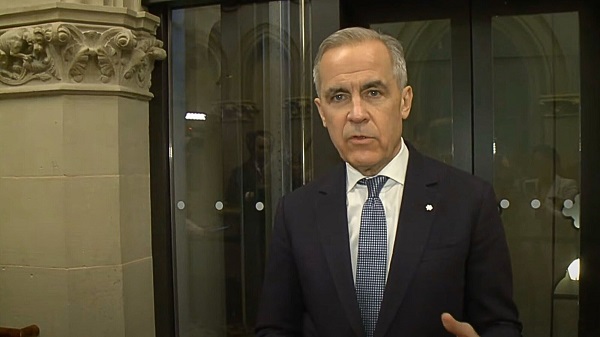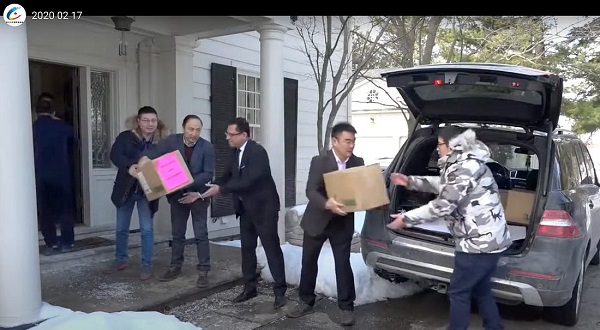Crime
Mystery Terrorist: The Unknown Life and Violent Times of Illegal Border-Crosser Sidi Mohammed Abdallahi
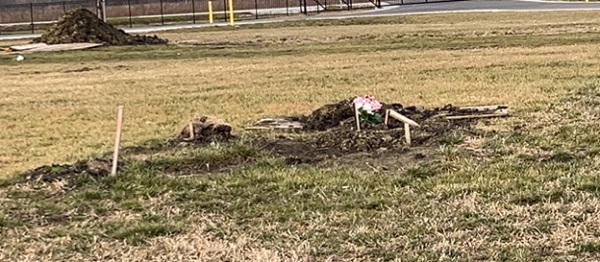
The most recent burial in a cost-free Muslim cemetery on the outskirts of Chicago in late December, possibly the burial site of Abdallahi, although the marker is the only one numbered rather than identified by name. Photo by Todd Bensman.
From the Center for Immigration Studies
First Blood, Part 2
By Todd Bensman
(Part 2 of 3; Read Part 1, Part 3.)

Abdallahi booking photo
CHICAGO, Illinois – If ever there was a magic moment for Americans to learn why Mauritanian national Sidi Mohammad Abdallahi rampaged through an Orthodox Jewish neighborhood firing a semi-automatic handgun at Jews and police, trying to rack up a body count, it was after he’d been dead a week on December 6, 2024.
“Prayers will be held over the body of the deceased” at 8:45 pm, read a post on the Chicago Mauritanian Community’s Facebook page. “Notice: Everyone is requested to come and pray for our bereaved. It is our right. Let us not forget also the virtue of a funeral, its follow-up and rewards.”
The funeral post drew several responses from the account’s 537 followers and drew one re-share.
“May God have mercy on him,” wrote Vadel Wel Belli, an active group member.
The 22-year-old Abdallahi, critically wounded then arrested by police, had hanged himself the week before while in the Cook County Jail while awaiting his eventual trial on state terrorism and other charges for conducting an October 26 shooting melee described at length in Part 1 of this series. (See First Blood: Anatomy of a Border-Crosser’s Chicago Terror Attack).

The pre-trial jailhouse suicide had made perfunctory news headlines, but any reporter who would have attended the Chicago Mauritanian Community’s publicly advertised “prayers…over the body of the deceased” and presumed burial of Abdallahi on Friday, December 6, could have potentially interviewed the people who knew him most intimately. A Facebook page that matches Abdallahi’s full name, devoid of entries other than a photo of a car, show five followers, among them some who follow the Chicago Mauritanian Community. But no reporters bothered to show up, missing what turned out to be a consequential opportunity to learn about Abdallahi’s violent path from the Mexican border to the West Rogers Park neighborhood, which he shot up during his 20-minute attack.
A Center for Immigration Studies (CIS) trip to Chicago two weeks after the funeral service, to learn what the cancelled trial might have revealed about the ground-breaking first charged terrorist attack by a border-crossing illegal immigrant, discovered a window onto Abdallahi’s world in Chicago.
A Pakistani man who parks several black hearses at what turned out to be a large Albanian mosque at the provided Facebook address, one of which displays a “Muslim Funeral Service” sign in a window, told CIS that Abdallahi had “relatives” in the area, the first known reference to that. They were the ones who accepted the body from the county Medical Examiner’s office and paid for the funeral service, he said.
The Pakistani funeral director refused to say anything more without the family’s permission, which he offered to secure for CIS. They never responded.
The Chicago Mauritanian community’s self-described leaders, many of them recent immigrants like Abdallahi, declined CIS interview requests to talk about Abdallahi, through an interlocutor who works closely with them.
And so, even the most basic information of homeland security value about Abdallahi and his path to violence, essential in helping authorities uncover violent plans by other illegal border-crossers from countries of terrorism concern like Mauritania, remains out of reach. It has already been reported that his phone and computer searches showed he was steeped in jihadist and pro-Hamas propaganda – and wore to his attack a green workman’s safety vest currently popular among pro-Hamas demonstrators. But that’s a small morsel.

A hearse at the address advertised for Sidi Mohammed Abdallahi’s December 6 funeral service.
One of the first of many rounds Abdallahi fired during the 20-minute spree went through a Jewish man’s back as he walked to synagogue and more toward police until officers critically wounded him. That white-knuckled morning of terror left Chicago’s Orthodox Jewish community deeply shaken and, with no trial coming, feeling an unrequited ache to know how this young foreign gunman was ever able to cross the U.S. southern border and attack their people with a semi-automatic pistol while screaming “Allahu Akbar.”
They still didn’t know two months later – and won’t ever, at least not from any trial.
“When they said ‘terrorism,’ it was just kind of shocking. It made us wonder if there’s much more to the story, that this guy wasn’t just some guy,” Abdallahi’s Jewish victim, who has fully recovered, told CIS in late December. “Like, what are we missing from this story? No one has given us any details or answers or anything.” (The victim spoke to CIS, in his first and only interview, on condition that his identity not be disclosed for fear of future targeting.)
“The safety piece is what’s scary,” he continued. “Like was he alone in this or was there somebody who coerced him to this? And if that’s the case, then okay, where are the rest of them and are they going to start infiltrating our neighborhood in some way? We still don’t have that answer, and that’s the scary thing.”
Many other questions hover over the incident unanswered but needed to enhance national security.
For instance, did U.S. Border Patrol and U.S. Immigration and Customs Enforcement (ICE) miss opportunities to detect his extremist ideology at the border or later on?
When Abdallahi crossed and passed a database check, was he ever detained and referred to the Border Patrol’s Tactical Terrorism Response Team or to ICE intelligence officers for extended terrorism-related interviews? That is supposed to happen with “special interest aliens,” who get assigned that tag if they hail from designated countries of terrorism concern like Mauritania.
According to material obtained by CIS through a Freedom of Information Act request, Border Patrol apprehended 18,260 Mauritanians (and hundreds of thousands of other special-interest aliens) who have illegally crossed the U.S. southern border from 2021 through December 2023, probably far too many for tedious direct interviews that can turn up signs of extremist beliefs.
If mistakes with Abdallahi remain unexplored, how then would the border agencies learn to interdict other potentially dangerous border-crossers already in the United States for a year or two?
Are co-conspirators who helped him or failed to report his plan still free or ruled out?
How exactly did Abdallahi, an illegal immigrant barred from obtaining a firearm in gun-restricted Chicago, get his hands on one and who might be held responsible?
What Is Known
ICE officials have confirmed that Abdallahi crossed the U.S. southern Border from Tijuana to San Diego on March 29, 2023. After a criminal and national security database check returned nothing derogatory, U.S. Border Patrol freed him on his own recognizance just as they have millions of other illegal entrants under orders from the Biden-Harris Department of Homeland Security.
Most often, those millions released were given dates to voluntarily report to ICE offices in their chosen destination city to file asylum claims or seek other forms of relief from deportation.
It’s unknown whether Abdallahi reported to ICE in Chicago or what the office knew of him. CIS has filed a Freedom of Information Act request to find out what ICE knew of him and when, if anything, but he may have obtained work authorization because Cook County prosecutors said at his detention hearing that he worked at a Chicago Amazon warehouse, and he had possession of a car where police found his phone after the shootout.

One of many obvious signs posted inside Midwest Sporting Goods gun store and range warns customers that they must have a state permit to touch a weapon. Photo by Todd Bensman.
The Gun Mystery
The phone contained more than 100 “antisemitic and pro-Hamas” images and videos, the prosecutor said. He’d used the phone to map local synagogues, including one just a couple of blocks from where he attacked the Jewish man. And his Google search history included a gun store in the suburb of Lyons.
The Jewish victim he shot said he dearly wants to know how his assailant got the gun.
So CIS visited the Lyons gun store and shooting range that came up in one of Abdallahi’s searches, Midwest Sporting Goods, and pretty much ruled out that he obtained the firearm there. The store’s manager said detectives came around too and found that there was no record that Abdallahi held a state-required FOID card permit required to legally buy, sell, or fire any handgun in Illinois – a rule the gun store rigorously enforces to stay out of trouble. There also was no evidence that Abdallahi might have come in with a friend who had the permit, she said.
It could have been stolen and sold on the black market. Whatever the handgun’s history, the manager noted, police probably know a lot about it since they recovered it after the attack.
Home Life and Times
At least for a time, Abdallahi lived in a crowded but somewhat renovated South Chicago flop house above a taco shop shared by five other young Mauritanian immigrants who also crossed the southern border.
The apartment in a dilapidated older neighborhood pockmarked by abandoned condemned buildings consisted of three disheveled bedrooms with two men in each, a kitchen and toilet facilities. A prayer rug was visible on the floor in one room. No one seemed interested in replacing the expired batteries on two chirping smoke detectors.
Two of Abdallahi’s former roommates confirmed that Abdallahi had lived there for a time and had relatives in the area, including a “cousin” who spoke good English but that they hardly knew Abdallahi well enough to meaningfully comment. CIS could not locate the relative.
“Yeah, he lived here. Yeah. Yeah. Yeah,” one young Mauritanian named Abdullah, who crossed the southern border in 2023, said in broken English. Police interviewed him a couple of times. “But I’m not talking to this guy. I not see this guy. I don’t know about this.”

The apartment Abdallahi shared with other illegal Mauritanian border crossers in South Chicago. Photo by Todd Bensman.
But Abdullah was definitive in saying that Abdallahi had never served in the Mauritanian military and also was angry about Israel’s war on Gaza as many in the community are.
“Too much Palestine! America give you everything to help you. Why do you have to go catch somebody outside of Palestine?” the young man opined.
A second Facebook page registered to Abdallahi’s unique name, recently taken down, showed that he had about 30 followers, most of them in Mauritania. Interestingly, Abdallahi followed the California Highway Patrol page in El Cajon, which is near the Mexican border.
Meanwhile, no one and no government agency seem interested in anything but moving on.
The FBI Closes Its Case; Other Agencies Fall Silent
Basic information to enhance public safety may remain unknown even to the most relevant federal law enforcement agency that investigates all suspected U.S. terrorism offenses, the FBI.
In this one rare instance, the FBI appears to have substantially ceded its role as primary investigator to the Chicago Police Department and Cook County Attorney’s office, which are arguably far less equipped for complex international and national terrorism cases even though they eventually lodged a state terrorism charge.
Two days after his attack, the only peep from the FBI came in a written statement that it would work “diligently with local, state, and federal partners to provide critical resources and assistance as we learn more.” The bureau disappeared after that, steering clear of the few press conferences that local authorities staged.
In response to a more recent inquiry by CIS, the FBI now says it has closed whatever support case it had opened, since the suspect is dead, and declined CIS interview requests to rule out or in co-conspirators or foreign direction or anything else that is important to know.
“It is common for investigations to be closed in conjunction with the US Attorney’s Office if a subject dies prior to the conclusion of an investigation,” the FBI’s Chicago Public Affairs Team wrote to CIS in a January 3 email.
CIS has filed a federal Freedom of Information request to the FBI for more information and is prepared to litigate it if necessary.
The FBI’s tack here is highly unusual in the annals of obvious U.S. terror attacks, regardless of body count.
Contrast this lack of curiosity with the recent New Years Day vehicle ramming attack in New Orleans, which killed 14 plus the driver, and the so-called “cybertruck” bombing in Las Vegas, during which nobody died but the driver. Even before a full news cycle passed, news media brimmed with exhaustive reports about the life and times of a U.S.-born terrorist who carried out the ISIS-inspired New Orleans attack. One reporter even took social media followers on a video tour inside the dead terrorist’s FBI-searched Houston residence, before his victim’s bodies were even cleared from the bloody scene.
Even with Abdallahi dead and the trial cancelled, both the Chicago Police Department and the Cook County prosecutor declined CIS interview requests for interviews about the case. CIS has filed numerous FOIA requests.
Short of congressional or Trump White House intervention on behalf of transparency, the FOIAs may hold the last hope that authorities can improve processes and interdict other illegal aliens raised in countries where extremist ideologies are common and who might be predisposed to also plan mass casualty violence.
Part 3: Solutions
Business
China, Mexico, Canada Flagged in $1.4 Billion Fentanyl Trade by U.S. Financial Watchdog
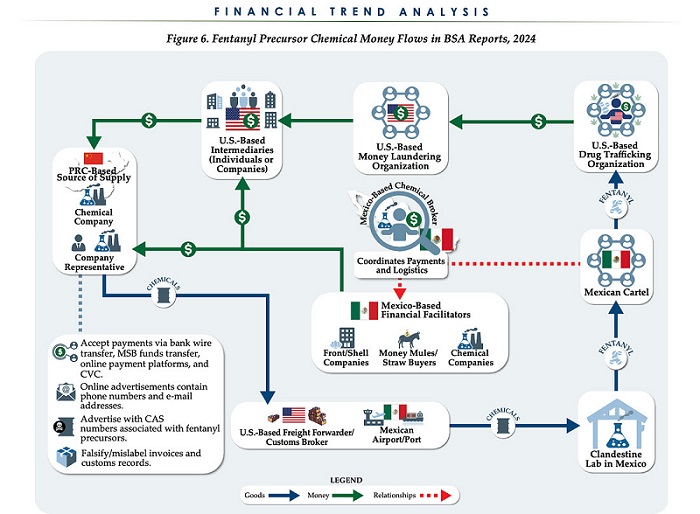
 Sam Cooper
Sam Cooper
The U.S. Treasury’s Financial Crimes Enforcement Network (FinCEN) has identified $1.4 billion in fentanyl-linked suspicious transactions, naming China, Mexico, Canada, and India as key foreign touchpoints in the global production and laundering network. The analysis, based on 1,246 Bank Secrecy Act filings submitted in 2024, tracks financial activity spanning chemical purchases, trafficking logistics, and international money laundering operations.
The data reveals that Mexico and the People’s Republic of China were the two most frequently named foreign jurisdictions in financial intelligence gathered by FinCEN. Most of the flagged transactions originated in U.S. cities, the report notes, due to the “domestic nature” of Bank Secrecy Act data collection. Among foreign jurisdictions, Mexico, China, Hong Kong, and Canada were cited most often in fentanyl-related financial activity.
The FinCEN report points to Mexico as the epicenter of illicit fentanyl production, with Mexican cartels importing precursor chemicals from China and laundering proceeds through complex financial routes involving U.S., Canadian, and Hong Kong-based actors.
The findings also align with testimony from U.S. and Canadian law enforcement veterans who have told The Bureau that Chinese state-linked actors sit atop a decentralized but industrialized global fentanyl economy—supplying precursors, pill presses, and financing tools that rely on trade-based money laundering and professional money brokers operating across North America.
“Filers also identified PRC-based subjects in reported money laundering activity, including suspected trade-based money laundering schemes that leveraged the Chinese export sector,” the report says.
A point emphasized by Canadian and U.S. experts—including former U.S. State Department investigator Dr. David Asher—that professional Chinese money laundering networks operating in North America are significantly commanded by Chinese Communist Party–linked Triad bosses based in Ontario and British Columbia—is not explored in detail in this particular FinCEN report.¹
Chinese chemical manufacturers—primarily based in Guangdong, Zhejiang, and Hebei provinces—were repeatedly cited for selling fentanyl precursors via wire transfers and money service businesses. These sales were often facilitated through e-commerce platforms, suggesting that China’s global retail footprint conceals a lethal underground market—one that ultimately fuels a North American public health crisis. In many cases, the logistics were sophisticated: some Chinese companies even offered delivery guarantees and customs clearance for precursor shipments, raising red flags for enforcement officials.
While China’s industrial base dominates the global fentanyl supply chain, Mexican cartels are the next most prominent state-like actors in the ecosystem—but the report emphasizes that Canada and India are rising contributors.
“Subjects in other foreign countries—including Canada, the Dominican Republic, and India—highlight the presence of alternative suppliers of precursor chemicals and fentanyl,” the report says.
“Canada-based subjects were primarily identified by Bank Secrecy Act filers due to their suspected involvement in drug trafficking organizations allegedly sourcing fentanyl and other drugs from traditional drug source countries, such as Mexico,” it explains, adding that banking intelligence “identified activity indicative of Canada-based individuals and companies purchasing precursor chemicals and laboratory equipment that may be related to the synthesis of fentanyl in Canada. Canada-based subjects were primarily reported with addresses in the provinces of British Columbia and Ontario.”
FinCEN also flagged activity from Hong Kong-based shell companies—often subsidiaries or intermediaries for Chinese chemical exporters. These entities were used to obscure the PRC’s role in transactions and to move funds through U.S.-linked bank corridors.
Breaking down the fascinating and deadly world of Chinese underground banking used to move fentanyl profits from American cities back to producers, the report explains how Chinese nationals in North America are quietly enlisted to move large volumes of cash across borders—without ever triggering traditional wire transfers.
These networks, formally known as Chinese Money Laundering Organizations (CMLOs), operate within a global underground banking system that uses “mirror transfers.” In this system, a Chinese citizen with renminbi in China pays a local broker, while the U.S. dollar equivalent is handed over—often in cash—to a recipient in cities like Los Angeles or New York who may have no connection to the original Chinese depositor aside from their role in the laundering network. The renminbi, meanwhile, is used inside China to purchase goods such as electronics, which are then exported to Mexico and delivered to cartel-linked recipients.
FinCEN reports that US-based money couriers—often Chinese visa holders—were observed depositing large amounts of cash into bank accounts linked to everyday storefront businesses, including nail salons and restaurants. Some of the cash was then used to purchase cashier’s checks, a common method used to obscure the origin and destination of the funds. To banks, the activity might initially appear consistent with a legitimate business. However, modern AI-powered transaction monitoring systems are increasingly capable of flagging unusual patterns—such as small businesses conducting large or repetitive transfers that appear disproportionate to their stated operations.
On the Mexican side, nearly one-third of reports named subjects located in Sinaloa and Jalisco, regions long controlled by the Sinaloa Cartel and Cartel Jalisco Nueva Generación. Individuals in these states were often cited as recipients of wire transfers from U.S.-based senders suspected of repatriating drug proceeds. Others were flagged as originators of payments to Chinese chemical suppliers, raising alarms about front companies and brokers operating under false pretenses.
The report outlines multiple cases where Mexican chemical brokers used generic payment descriptions such as “goods” or “services” to mask wire transfers to China. Some of these transactions passed through U.S.-based intermediaries, including firms owned by Chinese nationals. These shell companies were often registered in unrelated sectors—like marketing, construction, or hardware—and exhibited red flags such as long dormancy followed by sudden spikes in large transactions.
Within the United States, California, Florida, and New York were most commonly identified in fentanyl-related financial filings. These locations serve as key hubs for distribution and as collection points for laundering proceeds. Cash deposits and peer-to-peer payment platforms were the most cited methods for fentanyl-linked transactions, appearing in 54 percent and 51 percent of filings, respectively.
A significant number of flagged transactions included slang terms and emojis—such as “blues,” “ills,” or blue dots—in memo fields. Structured cash deposits were commonly made across multiple branches or ATMs, often linked to otherwise legitimate businesses such as restaurants, salons, and trucking firms.
FinCEN also tracked a growing number of trade-based laundering schemes, in which proceeds from fentanyl sales were used to buy electronics and vaping devices. In one case, U.S.-based companies owned by Chinese nationals made outbound payments to Chinese manufacturers, using funds pooled from retail accounts and shell companies. These goods were then shipped to Mexico, closing the laundering loop.
Another key laundering method involved cryptocurrency. Nearly 10 percent of all fentanyl-related reports involved virtual currency, with Bitcoin the most commonly cited, followed by Ethereum and Litecoin. FinCEN flagged twenty darknet marketplaces as suspected hubs for fentanyl distribution and cited failures by some digital asset platforms to catch red-flag activity.
Overall, FinCEN warns that fentanyl-linked funds continue to enter the U.S. financial system through loosely regulated or poorly monitored channels, even as law enforcement ramps up enforcement. The Drug Enforcement Administration reported seizures of over 55 million counterfeit fentanyl pills in 2024 alone.
The broader pattern is unmistakable: precursor chemicals flow from China, manufacturing occurs in Mexico, Canada plays an increasing role in chemical acquisition and potential synthesis, and drugs and proceeds flood into the United States, supported by global financial tools and trade structures. The same infrastructure that enables lawful commerce is being manipulated to sustain the deadliest synthetic drug crisis in modern history.
The Bureau is a reader-supported publication.
To receive new posts and support my work, consider becoming a free or paid subscriber.
Invite your friends and earn rewards
Business
Closing information gaps to strengthen Canada’s border security and track fentanyl

By Sean Parker, Dawn Jutla, and Peter Copeland for Inside Policy
To promote better results, we lay out a collaborative approach
Despite exaggerated claims about how much fentanyl is trafficked across the border from Canada to the United States, the reality is that our detection, search, and seizure capacity is extremely limited.
We’re dealing with a “known unknown”: a risk we’re aware of, but don’t yet have the capacity to understand its extent.
What’s more, it may be that the flow of precursor chemicals—ingredients used in the production of fentanyl—is where much of the concern lies. Until we enhance our tracking, search, and seizure capacity, much will remain speculative.
As border security is further scrutinized, and the extent of fentanyl production and trafficking gets brought into sharper focus, the role of the federal government’s Precursor Chemical Risk Management Unit (PCRMU)—announced recently by Health Canada—will become apparent.
Ottawa recently took action to enhance the capabilities of the PCRMU. It says the new unit will “provide better insights into precursor chemicals, distribution channels, and enhanced monitoring and surveillance to enable timely law enforcement action.” The big question is, how will the PCRMU track the precursor drugs entering into Canada that are used to produce fentanyl?
Key players in the import-export ecosystem do not have the right regulatory framework and responsibilities to track and share information, detect suspect activities, and be incentivized to act on it. That’s one of the reasons why we know so little about how much fentanyl is produced and trafficked.
Without proper collaboration with industry, law enforcement, and financial institutions, these tracking efforts are doomed to fail. To promote better results, we lay out a collaborative approach that distributes responsibilities and retools incentives. These measures would enhance information collection capabilities, incentivize system actors to compliance, and better equip law enforcement and border security services for the safety of Canadians.
Trade-off bottleneck: addressing the costs of enhanced screening
To date, it’s been challenging to increase our ability to detect, search, and seize illegal goods trafficked through ports and border crossings. This is due to trade-offs between heightened manual search and seizure efforts at ports of entry, and the economic impacts of these efforts.
In 2024, the Canada Border Services Agency (CBSA) admitted over 93 million travelers. Meanwhile, 5.3 million trucks transported commercial goods into Canada, around 3.6 million shipments arrived via air cargo, nearly 2 million containers were processed at Canadian ports, roughly 1.9 million rail cars carried goods into the country, and about 145.7 million courier shipments crossed the border. The CBSA employs a risk-based approach to border security, utilizing intelligence, behavioral analysis, and random selection to identify individuals or shipments that may warrant additional scrutiny. This triaging process aims to balance effective enforcement with the facilitation of legitimate travel and trade.
Exact percentages of travelers subjected to secondary inspections are not publicly disclosed, but it’s understood that only a small fraction undergo such scrutiny. We don’t learn about the prevalence of these issues through our border screening measures, but in crime reporting data—after it’s too late to avert.
It’s key to have an approach that minimizes time and personnel resources deployed at points of entry. To be effective without being economically disruptive, policymakers, law enforcement, and border security need to strengthen requirements for information gathering, live tracking, and sharing. Legislative and regulatory change to require additional information of buyers and sellers—along with stringent penalties to enforce non-compliance—is a low-cost, logistically efficient way of distributing responsibility for this complex and multifaceted issue. A key concept explored in this paper is strengthening governance controls (“controls”) over fentanyl supply chains through new processes and data digitization, which could aid the PCRMU in their strategic objectives.
Enhanced supply chain controls are needed
When it comes to detailed supply chain knowledge of fentanyl precursor chemicals moving in and out of Canada, regulator knowledge is limited.
That’s why regulatory reform is the backbone of change. It’s necessary to ensure that strategic objectives are met by all accountable stakeholders to protect the supply chain and identify issues. To rectify the issues, solutions can be taken by the PCRMU to obtain and govern a modern fentanyl traceability system/platform (“platform”) that would provide live transparency to regulators.
A fresh set of supply chain controls, integrated into a platform as shown in Fig. 1, could significantly aid the PCRMU in identifying suspicious activities and prioritizing investigations.

Our described system has two distinctive streams: one which leverages a combination of physical controls such as package tampering and altered documentation against a second stream that looks at payment counterparties. Customs agencies, transporters, receivers, and financial institutions would have a hand in ensuring that controls in the platform are working. The platform includes several embedded controls to enhance supply chain oversight. It uses commercially available Vision AI to assess packaging and blockchain cryptography to verify shipment documentation integrity. Shipment weight and quantity are tracked from source to destination to detect diversion, while a four-eyes verification process ensures independent reconciliation by the seller, customs, and receiver. Additionally, payment details are linked to shipments to uncover suspicious financial activity and support investigations by financial institutions and regulators like FINTRAC and FINCEN.
A modern platform securely distributes responsibility in a way that’s cost effective and efficient so as not to overburden any one actor. It also ensures that companies of all sizes can participate, and protects them from exploitation by criminals and reputational damage.
In addition to these technological enhancements and more robust system controls, better collaboration between the key players in the fentanyl supply chain is needed, along with policy changes to incentivize each key fentanyl supply chain stakeholder to adopt the new controls.
Canadian financial institutions: a chance for further scrutiny
Financial institutions (FIs) are usually the first point of contact when a payment is being made by a purchaser to a supplier for precursor chemicals that could be used in the production of fentanyl. It is crucial that they enhance their screening and security processes.
Chemicals may be purchased by wires or via import letters of credit. The latter is the more likely of the two instruments to be used because this ensures that the terms and conditions in the letter of credit are met with proof of shipment prior to payment being released. Payments via wire require less transparency.
Where a buyer pays for precursor chemicals with a wire, it should result in further scrutiny by the financial institution. Requests for supporting documentation including terms and conditions, along with proof of shipment and receipt, should be provided. Under new regulatory policy, buyers would be required to place such supporting documentation on the shared platform.
The less transparent a payment channel is in relation to the supply chain, the more concerning it should be from a risk point of view. Certain payment channels may be leveraged to further mask illicit activity throughout the supply chain. At the onset of the relationship the seller and buyers would link payment information on the platform (payment channel, recipient name, recipient’s bank, date, and payment amount) to each precursor or fentanyl shipment. The supplier, in turn, should record match payment information (payment channel, supplier name, supplier’s bank, date, and payment amount).
Linking payment to physical shipment would enable data analytics to detect irregularities. An irregularity is flagged when the amounts and/or volume of payments far exceed the value of the received goods or vice versa. The system would be able to understand which fentanyl supply chains tend to use a particular set of FIs. This makes it possible to conduct real-time mapping of companies, their fentanyl and precursor shipments and receipts, and the payment institutions they use. With this bigger picture, FIs and law enforcement could connect the dots faster.
Live traceability reporting
Today, suppliers of fentanyl precursors are subject to the Pre-Export Notification Online (PEN Online) database. This database enables governments to monitor international trade in precursor chemicals by sending and receiving pre-export notifications. The system helps prevent the diversion of chemicals used in the illicit manufacture of drugs by allowing authorities to verify the legitimacy of shipments before they occur.
To further strengthen oversight, the platform utilizes immutability technologies—such as blockchain or secure immutable databases—which can be employed to encrypt all shipping documents and securely share them. This presents an auditable form of chain-of-custody and makes any alterations apparent. Customs and buyers would have the capability to verify the authenticity of the originating documents in a way that doesn’t compromise business confidentiality. With the use of these technologies, law enforcement can narrow down their investigations.
An information gap currently exists as the receivers of the shipments don’t share their receipts information with PEN. To strengthen governance on fentanyl supply chains, regulatory policy and legislative changes are needed. The private sector should be mandated to report received quantities of fentanyl or its precursors, as well as suspicious receiving destinations. This could be accomplished on the platform which would embed the receiving process, a reconciliation process of the transaction, the secure upload and sharing of documents, and would be minimally disruptive to business processes.
Additionally, geo-location technology embedded in mobile devices and/or shipments would provide real-time location-based tracking of custody transactions. These geo-controls would ensure accountability across the fentanyl supply chain, in particular where shipments veer off or stop too long on regular shipping routes. Canadian transporters of fentanyl and its precursor chemicals should play an important role in detecting illicit diversion/activities.
Digital labelling
Licensed fentanyl manufacturers could add new unique digital labels to their shipments to get expedited clearance. For example, immutable digital labelling platforms enable tamper-proof digital labels for legitimate fentanyl shipments. This would give pharmacies, doctors, and regulators transparency into the fentanyl’s:
- Chemical composition and concentrations (determining legitimate vs. adulterated versions of the drug)
- Manufacturing facility ID, batch ID, and regulatory compliance status
- Intended buyer authentication (such as licensed pharmaceutical firms or distributors)
Immutable digital labelling platforms offer secure role-based access control. They can display customized data views according to time of day, language, and location. Digital labels could enable international border agencies and law enforcement to receive usable data, allowing legal shipments through faster while triggering closer shipment examinations for those without of a digital label.
International and domestic transporter controls
Transporters act as intermediaries in the supply chain. Their operations could be monitored through a regulatory policy that mandates their participation in the platform for fentanyl and precursor shipments. The platform would support a mobile app interface for participants on-the-move, as well as a web portal and application programming interfaces (APIs) for large-size supply chain participants. Secure scanning of packaging at multiple checkpoints, combined with real-time tracking, would provide an additional layer of protection against fraud, truckers taking bribes, and unauthorized alterations to shipments and documents.
Regulators and law enforcement participation
Technology-based fentanyl controls for suppliers, buyers, and transporters may be reinforced by international customs and law enforcement collaboration on the platform. Both CBSA and law enforcement could log in and view alerts about suspicious activities issued from the FIs, transporters, or receivers. The reporting would allow government personnel to view a breakdown of fentanyl importers, the number of import permit applications, and the amount of fentanyl and its precursors flowing into the country. Responsible regulatory agencies—such as the CBSA and PCRMU—could leverage the reporting to identify hot spots.
The platform would use machine learning to support CBSA personnel in processing an incoming fentanyl or precursor shipment. Machine learning refers to AI algorithms and systems that improve their knowledge with experience. For example, an AI assistant on the traceability system could use machine learning to predict and communicate which import shipments arriving at the border should be passed. It can base these suggestions on criteria like volume, price, origin of raw materials, and origin of material at import point. It can also leverage data from other sources such as buyers, sellers, and banks to make predictions. As an outcome, the shipment may be recommended to pass, flagged as suspicious, or deemed to require an investigation by CBSA.
It’s necessary to keep up to date on new precursor chemicals as the drug is reformulated. Here, Health Canada can play a role, using its new labs and tests—expected as part of the recently announced Canadian Drug Analysis Centre—to provide chemical analysis of seized fentanyl. This would inform which additional chemical supply chains should be tracked in the PCRMU’s collaborative platform, and all stakeholders would widen their scope of review.
These new tools would complement existing cross-border initiatives, including joint U.S.-Canada and U.S.-Mexico crackdowns on illicit drug labs, as well as sovereign efforts. They have the potential to play a vital role in addressing fentanyl trafficking.
A robust, multi-pronged strategy—integrating existing safeguards with a new PCRMU traceability platform—could significantly disrupt the illegal production and distribution of fentanyl. By tracking critical supply chain events and authenticating shipment data, the platform would equip law enforcement and border agencies in Canada, the U.S., and Mexico with timely, actionable intelligence. The human toll demands urgency: from 2017 to 2022, the U.S. averaged 80,000 opioid-related deaths annually, while Canada saw roughly 5,500 per year from 2016 to 2024. In just the first nine months of 2024, Canadian emergency services responded to 28,813 opioid-related overdoses.
Combating this crisis requires more than enforcement. It demands enforceable transparency. Strengthened governance—powered by advanced traceability technology and coordinated public-private collaboration—is essential. This paper outlines key digital controls that can be implemented by global suppliers, Canadian buyers, transporters, customs, and financial institutions. With federal leadership, Canada can spearhead the adoption of proven, homegrown technologies to secure fentanyl supply chains and save lives.
Sean Parker is a compliance leader with well over a decade of experience in financial crime compliance, and a contributor to the Macdonald-Laurier Institute.
Dawn Jutla is the CEO of Peer Ledger, the maker of a traceability platform that embeds new control processes on supply chains, and a professor at the Sobey School of Business.
Peter Copeland is deputy director of domestic policy at the Macdonald-Laurier Institute.
-

 2025 Federal Election2 days ago
2025 Federal Election2 days agoRCMP Whistleblowers Accuse Members of Mark Carney’s Inner Circle of Security Breaches and Surveillance
-
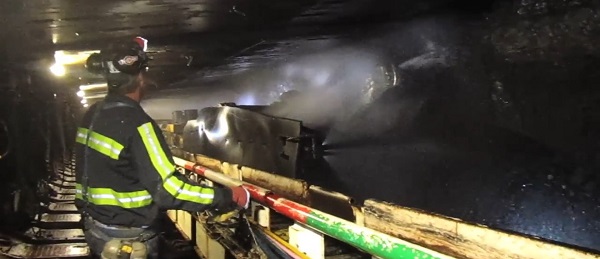
 Daily Caller20 hours ago
Daily Caller20 hours agoTrump Executive Orders ensure ‘Beautiful Clean’ Affordable Coal will continue to bolster US energy grid
-
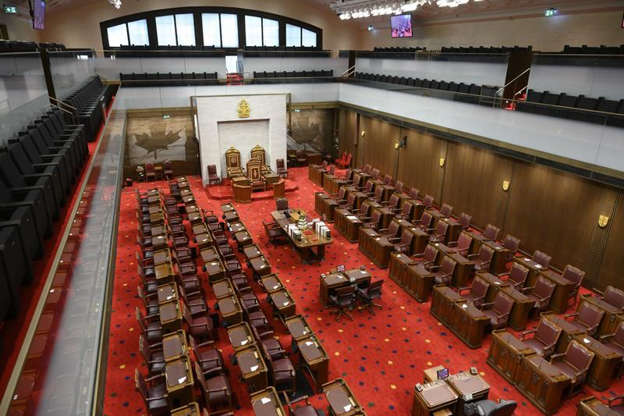
 2025 Federal Election2 days ago
2025 Federal Election2 days agoBureau Exclusive: Chinese Election Interference Network Tied to Senate Breach Investigation
-

 Business22 hours ago
Business22 hours agoChina, Mexico, Canada Flagged in $1.4 Billion Fentanyl Trade by U.S. Financial Watchdog
-

 2025 Federal Election20 hours ago
2025 Federal Election20 hours agoBREAKING from THE BUREAU: Pro-Beijing Group That Pushed Erin O’Toole’s Exit Warns Chinese Canadians to “Vote Carefully”
-

 2025 Federal Election1 day ago
2025 Federal Election1 day agoTucker Carlson Interviews Maxime Bernier: Trump’s Tariffs, Mass Immigration, and the Oncoming Canadian Revolution
-
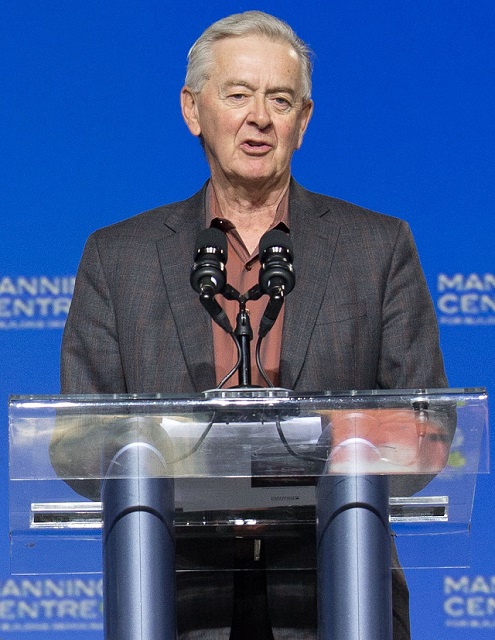
 2025 Federal Election18 hours ago
2025 Federal Election18 hours agoAllegations of ethical misconduct by the Prime Minister and Government of Canada during the current federal election campaign
-
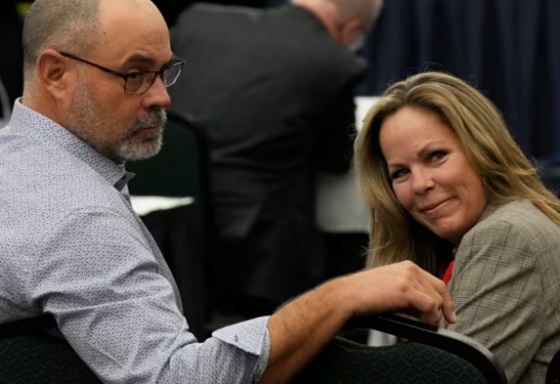
 COVID-1915 hours ago
COVID-1915 hours agoTamara Lich and Chris Barber trial update: The Longest Mischief Trial of All Time continues..






